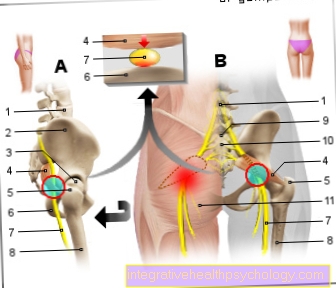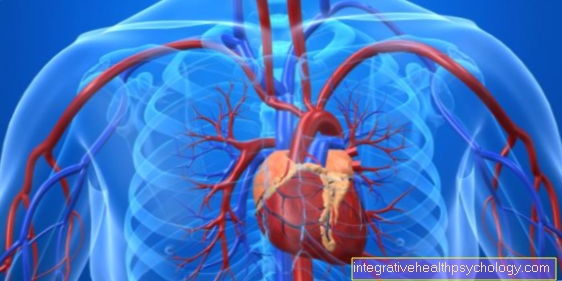Therapy for post-traumatic stress disorder (PTSD)
therapy
There are many different approaches that can be used to treat post-traumatic stress disorder.
- Conveying the disorder model: The aim here is to make the factors that are highly frightening for the patient more comprehensible. By explaining the disorder and its typical symptoms to the patient, the therapist simultaneously creates an understanding of further therapeutic approaches
Example:
In our experience, for example, the “picture of the wardrobe” has proven to be quite helpful. If a person's memory is a wardrobe, then the thoughts could be called clothes. Usually the clothes are neatly folded and stored in specific shelves and compartments. Whenever you are looking for a particular memory, you usually know very well where to find it.
The PTSD disease model also understands the trauma as a memory that is in this closet. Since one often feels what has been experienced and remembered to be so strange and terrible and, moreover, it happened so unexpectedly, this memory is not folded and ironed. You just "throw" it in the closet as it is and slam the door. The problem with such cabinets, however, is that, when they are not tidied up, they sometimes reveal their contents again without being asked, e.g. want a completely different compartment in the closet. For the sick person this means that the memories can unintentionally break in on him. To protect yourself from this, it is essential to tidy up the closet sooner rather than later. To do this, you have to take out all the individual pieces of clothing (splinters and fragments of memories of the trauma), look at yourself, fold them up and put them in the closet.
- Thoughtful reliving of the trauma: Earlier opinions thought that memories or addressing traumatic events could lead to a worsening of the whole disorder. This opinion is no longer tenable today (with a few exceptions). The therapeutic reliving of the trauma is a very strenuous, but also promising way to bring about improvement, if it is carried out by a therapist experienced in trauma therapy and a few important rules are observed by both the patient and the therapist.
- The order of the imagined (presented) events must correspond to the order of the actual events.
- The described events are told in the “first person” and in the “present”.
- In describing the events, feelings, thoughts and other impressions should also be conveyed.
- Feelings must not be suppressed.
- The patient always has control over the speed with which one experiences and describes
The therapist looks after the patient during the Reliving supportive and especially after the meeting discusses what has been described.
The aim of this therapy step is the so-called Habituation, but also the processing of the trauma, as well as the correct storage in the memory. This means that the whole event is put in a context to one's own person and thus becomes a permanent one in the course of the event Decrease in anxiety comes. The trauma becomes part of the past. Trauma-specific stimuli (smells, colors, etc.) can also be found and processed.
- Dealing with the trauma on site (in vivo exposure):
The aim of this method is for the patient to learn to accept the trauma as part of their past. To do this, the therapist and your patient visit the scene of the event. This therapy step will, on the one hand, sharpen the perspective between "now in the moment" and "then during the trauma" and on the other hand it will also be possible to work on the understanding of one's own "guilt" (e.g. the accident could not have been prevented here at all ). The patient can also experience that the disaster will not repeat itself if he is in the same place (e.g. driving past an accident site or stopping there).
- Cognitive restructuring:
As with many other mental disorders, PTSD involves a change in thinking. Often people who have experienced trauma feel isolated from others, change their view of the world or themselves, or sometimes even feel that the trauma is no longer viable. People with PTSD are also often prone to pronounced brooding or strong outbursts of anger. Changing these thought patterns and thus improving the patient's quality of life must therefore also be the goal of trauma therapy. Here it e.g. on the part of the therapist for the logical analysis of entrenched lines of thought or for the development of alternative lines of thought. (e.g. thoughts like "The world is dangerous", "You can't trust anyone anymore" or "I'm always unlucky")
- Stress management training: This term includes e.g. Relaxation methods (progressive muscle relaxation, autogenic training, etc.), breathing techniques, self-confidence training, "thought stopping" training. These procedures should be in addition to the above used to measure the general state of arousal (insomniaNervousness or nervousness)
- Hypnotherapy: Hypnosis allows access to the "unconscious" and is thus a way to the unrecognized parts of the trauma. However, there is a risk of dissociation.
Dissociation:
Dissociation describes a change in one's own perception, one's own thinking, but also one's own controlled movement. Often patients without a specific trigger get into this state, which is perceived as very strange by the environment. You are not "completely in the world" here. You are e.g. unresponsive and unable to move. After a while these symptoms disappear and patients often cannot remember what happened.
- Eye movement desensitization / EMDR: This is a fairly new method of trauma therapy. During therapy, the patient's eyes follow the finger of the therapist who is sitting in front of him. The patient is asked to recall various trauma-relevant situations, including the thoughts and feelings associated with them. Although the actual mechanism is still unclear, the eye movements that are carried out at the same time as the trauma thoughts lead to an improved processing of the experience.
Author's note: The whole thing sounds a bit like "Voodoo", but the author of these lines has actually gained some personal experience and must therefore say that it works. Trauma can lose its horror.
- Medication: Nowadays, antidepressants (SSRIs or tricyclics) are typically used in supportive trauma therapy (see also Antidepressants). Benzodiazepines (Valium ®, Tavor ®, oxazepam) belong in inpatient treatment for a short time at best.Under no circumstances should they be used in outpatient therapy, as there is an increased risk of addiction.


















.jpg)





.jpg)




